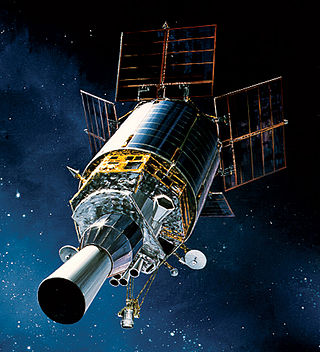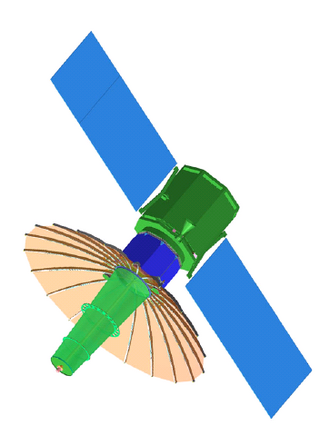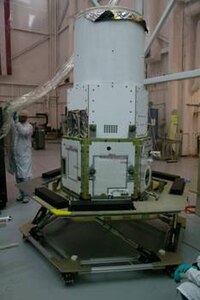
The Air Force Research Laboratory (AFRL) is a scientific research and development detachment of the United States Air Force Materiel Command dedicated to leading the discovery, development, and integration of direct-energy based aerospace warfighting technologies, planning and executing the Air Force science and technology program, and providing warfighting capabilities to United States air, space, and cyberspace forces. It controls the entire Air Force science and technology research budget which was $2.4 billion in 2006.

The Defense Support Program (DSP) is a program of the United States Space Force that operated the reconnaissance satellites which form the principal component of the Satellite Early Warning System used by the United States.

Schriever Space Force Base, previously Schriever Air Force Base, Falcon Air Force Base, and Falcon Air Force Station, is a base of the United States Space Force located approximately 10 mi (16 km) east of Peterson Space Force Base near Colorado Springs in El Paso County, Colorado, United States.

Time History of Events and Macroscale Interactions during Substorms (THEMIS) mission began in February 2007 as a constellation of five NASA satellites to study energy releases from Earth's magnetosphere known as substorms, magnetic phenomena that intensify auroras near Earth's poles. The name of the mission is an acronym alluding to the Titan Themis.

TacSat-2 is the first in a series of U.S. military experimental technology and communication satellites.TacSat-2 (also known as JWS-D1 was an experimental satellite built by the USAF's Air Force Research Laboratory with an operational life expected to be not more than one year as part of the "Advanced Concept Technology Demonstration" program.

TacSat-1 was an experimental satellite built by the Naval Research Laboratory (NRL) on behalf of the United States Department of Defense (DoD) Office of Force Transformation (OFT). It was the planned payload of the sixth launch of the SpaceX Falcon 1. It was however never launched into space. The second satellite in the series, TacSat-2, launched before TacSat-1 and this led to the cancellation of TacSat-1's launch.

GPS satellite blocks are the various production generations of the Global Positioning System (GPS) used for satellite navigation. The first satellite in the system, Navstar 1, was launched on 22 February 1978. The GPS satellite constellation is operated by the 2nd Space Operations Squadron (2SOPS) of Space Delta 8, United States Space Force.
The Operationally Responsive Space Office is a joint initiative of several agencies within the United States Department of Defense (DoD). The "stand up" of the office took place 21 May 2007 at Kirtland Air Force Base. The first director of the ORS Office was Col. Kevin McLaughlin, who was also dual-hatted as commander of the Space Development and Test Wing located at Kirtland. The ORS Office focuses on providing quick-response tactical space-based capabilities to the warfighter utilizing smaller satellites, such as the Tactical Satellite Program and smaller launch vehicles.
The Space Based Space Surveillance (SBSS) system is a planned United States Space Force constellation of satellites and supporting ground infrastructure that will improve the ability of the United States Department of Defense (DoD) to detect and track space objects in orbit around the Earth. The primary SBSS contractor, Boeing, characterizes some orbiting space objects as, "Potential future threats to the United States' space assets".

Minotaur IV, also known as Peacekeeper SLV and OSP-2 PK is an active expendable launch system derived from the LGM-118 Peacekeeper ICBM. It is operated by Northrop Grumman Innovation Systems, and made its maiden flight on 22 April 2010, carrying the HTV-2a Hypersonic Test Vehicle. The first orbital launch occurred on 26 September 2010 with the SBSS satellite for the United States Air Force.

TacSat-4 is the third in a series of U.S. military experimental technology and communication satellites. The United States Naval Research Laboratory (NRL) is the program manager. The Office of Naval Research (ONR) sponsored the development of the payload and funded the first year of operations. The Office of the Director of Defense Research and Engineering (DDR&E) funded the standardized spacecraft bus and the Operationally Responsive Space Office (ORS) funded the launch that will be performed by the Air Force's Space and Missile Systems Center (SMC).

During the second half of 2002, the Naval Research Laboratory studied the tactical application of space assets. Relatively new technologies and processes in the areas of microsatellites, affordable and quick-response launch vehicles, and the classified SIPRNet made tactical use of space assets possible in the relatively near term. The DoD's Office of Force Transformation (OFT) agreed with the core findings of the study and decided to start an Operationally Responsive Space (ORS) Initiative consisting of a series of experiments. TacSat-1 is the first experiment in this OFT initiative. The TacSat-1 experiment received go-ahead on 7 May 2003.
AeroCube-3 is a single-unit CubeSat which was built and is being operated by The Aerospace Corporation, at El Segundo, California. It is the third AeroCube picosatellite, following on from AeroCube-1, which was lost in a launch failure in 2006, and AeroCube-2 which was successfully launched in 2007 but failed immediately after launch. Compared to its predecessors it contains several improvements in its infrastructure, including a redesigned power system, replacing the older system which was responsible for the loss of AeroCube-2. Its development was funded by the United States Air Force Space and Missile Systems Center, at Los Angeles Air Force Base.
HawkSat-1 was a single-unit CubeSat which was built and is being operated by the Hawk Institute for Space Sciences (HISS), Pocomoke City, Maryland. It is based on a Pumpkin Inc. CubeSat kit, and carries a technology demonstration payload, primarily as a proof of concept mission, testing command, data and power subsystems, as well as solar panels and communications.

EWS-G1 is a weather satellite of the U.S. Space Force, formerly GOES-13 and part of the National Oceanic and Atmospheric Administration's Geostationary Operational Environmental Satellite system. On 14 April 2010, GOES-13 became the operational weather satellite for GOES-East. It was replaced by GOES-16 on 18 December 2017 and on 8 January 2018 its instruments were shut off and it began its three-week drift to an on-orbit storage location at 60.0° West longitude, arriving on 31 January 2018. It remained there as a backup satellite in case one of the operational GOES satellites had a problem until early July 2019, when it started to drift westward and was being transferred to the U.S. Air Force, and then the U.S. Space Force.

Lunar Flashlight was a low-cost CubeSat lunar orbiter mission to explore, locate, and estimate size and composition of water ice deposits on the Moon for future exploitation by robots or humans.

Lunar IceCube is a NASA nanosatellite orbiter mission that was intended to prospect, locate, and estimate amount and composition of water ice deposits on the Moon for future exploitation. It was launched as a secondary payload mission on Artemis 1, the first flight of the Space Launch System (SLS), on 16 November 2022. As of February 2023 it's unknown whether NASA team has contact with satellite or not.

Space Base Delta 2 is a garrison delta in the United States Space Force. It is responsible for providing installation support functions for the resident air operations, space-based missile warning capabilities, space surveillance operations, and space communications missions at Buckley Space Force Base, Cape Cod Space Force Station, Cavalier Space Force Station, and Clear Space Force Station. It also provides airmen and guardians that deploy and are deployed in-place, to accomplish warfighting missions globally.





















